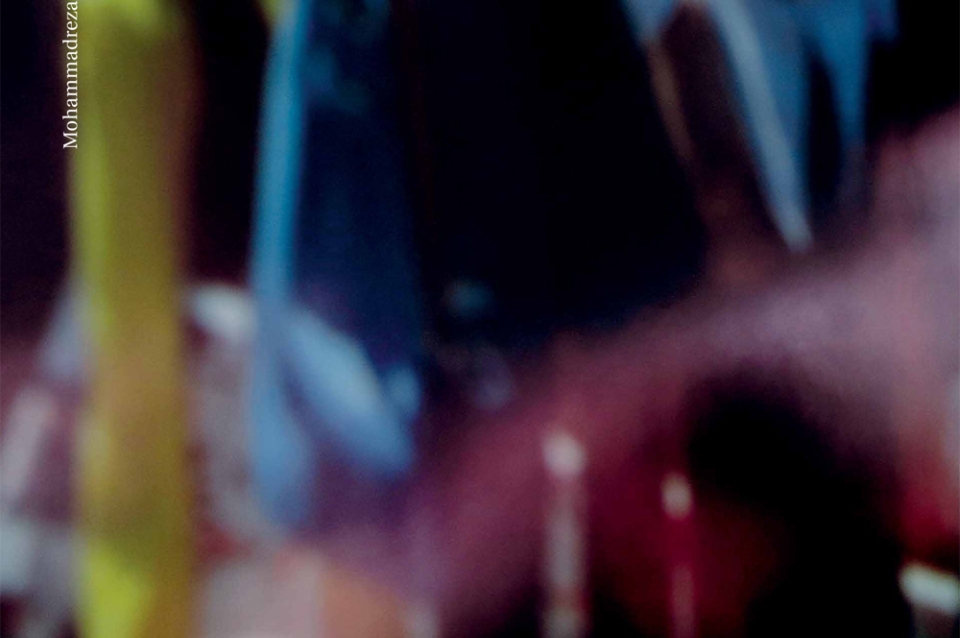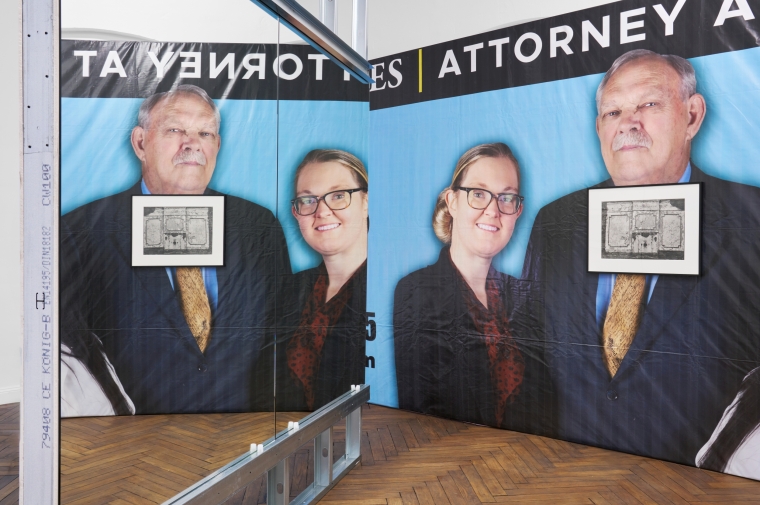February 5, 2015
Stuart Weitzman School of Design
102 Meyerson Hall
210 South 34th Street
Philadelphia, PA 19104
Get the latest Weitzman news in your Inbox
Areas
The Graduate Department of Fine Arts at the University of Pennsylvania School of Design and the University of Pennsylvania Common Press are pleased to present Here Comes the Sun, a photobook by Mohammadreza Mirzaei. The book is designed by Filippo Nostri and contains 21 color plates, writing by Mirzaei, and an essay by Carlos Basualdo (full essay is below).
In Here Comes the Sun, photography is not only a medium which can gives a form to Mirzaei’s representation, but also the subject of his work. Basualdo writes, "If Mirzaei began by fearing that nothing of the world would be revealed now he seems intended to make us turn away from what’s appeared in front of us. Lack of language, before, to talk about the world surrounding us, lack of feeling afterwards, to talk about ourselves. We clearly see that the question that this book attempts to pose concerns the very possibility of seeing, only inasmuch as our vision defines our very selves. What can we really see, and what do we become while seeing it? What it is left for us to see? Deraciné, in a foreign city and a foreign language, Mirzaei firmly grasps the chance to think with images about images themselves."
Mohammadreza Mirzaei is an Iranian artist who is now living and working in Tehran. The images included in this book are all made while he was pursuing his MFA at University of Pennsylvania, from 2012 to 2014.
Carlos Basualdo is the Keith L. and Katherine Sachs Senior Curator of Contemporary Art at the Philadelphia Museum of Art and is also a senior critic in the Interdisciplinary Master of Fine Arts Program at the University of Pennsylvania.
The two-year Master of Fine Arts program at Penn is focused on the professional development of studio artists. Through studio work, seminar courses, international residency opportunities and interactions with vital working artists, the program provides an open intellectual framework to foster critical awareness and independent methods of artistic research. Students extend their conceptual strategies while inventing and then refining their own hybridized forms of art making methods. The program encourages exploration, extending studies into other disciplines within the School of Design and the university-at-large with a rich selection of outside electives and optional certificate and dual-degree programs.
Here Comes the Sun
University of Pennsylvania Common Press
52 pages
21 color plates
20 x 30 cm
ISBN: 978-0-692-29127-6
Printed in Italy
HERE COMES THE SUN
On a book of photographs by Mohammadreza Mirzaei
By Carlos Basualdo (2014)
The glowing world escapes us. It is what we cannot see. It is ourselves that block the world from view. Our limited physical bodies, our impoverished language, our distracted minds. Our own boundaries confront us, without mercy. The world implacably frames our distractions, with a clinical precision that constantly remind us that there is another scene where the game is truly played. What we cannot see blocks our vision. It is right in front of us, too close, out of focus. It is our bodies, our limited mind, at the very forefront of our sense or selves while at the same time far and remote, endowed with the intangibility of secret evidence. The brightest colors lie to the right and to the left of that scene, clinging to the corners of our vision, he illuminated signs and the shining metal. We can barely see them: hints of a storefront window, like an immense aquarium of condensed desire, with dark letters floating high above; nothing to possess and yet those traces of a broken world persist in haunting us. Then all of a sudden we notice a car that passes by at sunset, leaving a bright orange trail condensed in a word in neon letters, “alterations.”
The photographer, Mohammadreza Mirzaei opens his book – this book – with three images that do not seem complete. Each of the images confronts us with a foreground blocking the view. Three times we are faced with the limits of our vision, with the neatly framed boundaries of our own ability to discern in these first photographs a possibly world of activity, context or meaning. Meaning is given, instead, as a fragmented and partial byproduct of the very impossibility to capture a complete scene; an unbroken photographic rendition of the world outside. And nonetheless, even though Mirzaei insistently confronts us with fragments – a metal pole perhaps, out of focus, that looks more like the amplified skin of an abstract watermelon, and then two solid surfaces, walls of textured red and solid white -, we still hold our breath in anticipation at the sight of the slivers of a world that his camera both captures and expels. They frame nothing but the deafness that plays a protagonistic role in these first photographs. With eerie precision, the images evoke the sound of a mute brass band; in the background we see the light reflected on the polished metals and we notice the musician’s busy movements, but the sounds are barely perceptible, as if they were emitted through a dense layer of cotton. Is it our bodies made of cotton, or our minds? Images that do not have a language, it is us who speak to them, incessantly, distracted from ourselves. And what we hear when looking at these photographs is but the solid mass of our own words, a wall of lamentations.
Everything explodes at night, when we close our eyes and do not see. It is in darkness that the world begins to dance at its own rhythm. The darkest sky is but a constellation of incandescent promises, broken by their sheer and mad intensity. The next image in the book is documents that celebration. At first sight it seems a dark rendition of the most delicate and secret fireworks. Then we see it is just grass. The shiny blades of grass long for the light until they grasp it. It is a multitude of thin vegetable tendrils that are suddenly awakened. They call for light and air and our attention, and once they reach it they seize it and return it to their darkest inner selves. In the opposite page of the book, diagonally across from the dark field of shining grass, Mirzaei makes a grassy landscape burst into a cosmic rain of falling stars, an image of such madly joy that seems to mimic an orgiastic explosion. For once, everything is suddenly there for us to see, day and night brought together. And even though the light is everywhere present, and the grass itself seems to emanate light, the image persists in its remoteness, as if soaked in distance. It is not our joy, but joy existing in itself, outside of our reach.
What follows - and it should be clear by now that this book has been carefully structured as a narrative – is a series of night scenes that are among the first photographs that Mirzaei took of Philadelphia when he first arrived in town. They are painfully evocative images of this city. Their beauty consists in the fact that Mirzaei has renounced, from the beginning, to rely on any form of anecdote or adorn, to linger in any easily recognizable urban feature. There is no clear allusion to a specific time or locale, just a pervasive veil of black, all velvet and surface, that transpires the faintest traces of a barely lighted corner, a bench made of concrete, or the faint numbers of an illuminated sign. The pitch night in the photographs is more than the mere absence of color; it is the sweet acquiescence to a deeper sense of loss, a resignated appeal without recipient. Mirzaei, we might infer, is photographing his own struggles to come to terms with his new urban landscape, his own sense of lack of words or point of reference. Perhaps, but more fundamentally these processes are truest to what this city, as any city, tries incessantly to conceal, its monumental anonymity hidden in a changing mass of dizzying images.
And then the sun comes back again, and the glowing breeze blowing upon bridges, and a glorious mountain range against a phosphorescent sky. What follows in the book after an interlude of digital haze, is a series of eight images of seascapes and mountain landscapes, with bridges of sheet light traveling upon pools of psychedelic water. It all looks like an enormous fire, perhaps the burning of the Houses of Parliament by J.M.W. Turner. It is as if the world would be enacting a massive revenge, unveiling itself for all to see, shedding layer upon layer of subtlety and darkness, becoming all saturated glow and brilliance. But in their extreme form of visibility, none of these photographs constitute a revelation. They almost exist before themselves, not quite formed as images yet, as if they would have been brought to light a bit too hurriedly. They have forgotten the words of the message they were meant to convey. It is not that they seem distant, but their immediacy rings false and their spontaneity betrays artifice and fiction. If Mirzaei began by fearing that nothing of the world would be revealed now he seems intended to make us turn away from what’s appeared in front of us. Lack of language, before, to talk about the world surrounding us, lack of feeling afterwards, to talk about ourselves. We clearly see that the question that this book attempts to pose concerns the very possibility of seeing, only inasmuch as our vision defines our very selves. What can we really see, and what do we become while seeing it? What is left for us to see? Déraciné, in a foreign city and a foreign language, Mirzaei firmly grasps the chance to think with images about images themselves.
What is then left? In the last page of the book we find what looks as a provisional response. We see a slow pool of dirty snow, melting in the night.
What is left for us to see if it is our physical bodies, our own distracted minds that block the view? If seeing is but looking for, and what we chase after is only partially suggested in the margins of our visual language, a promise land that lies beyond imagination? What is left for us to see if we see always through a mirror, like Corinthians say, in darkness? And our conquered lands, the fiefdom of the near and familiar, at least reveal themselves a mantle lying upon blindness and disorientation. What is left for us to see in a world where images have burned their bridges one by one, and whatever fragments remain lie scattered across swirling pools of broken color? Re-photographed postcards become shinier, until the shine is blinding. For a year Mirzaei stories and his photographs have insisted in telling stories, fictional or not, about desire disguised as love, and devotion made into a pointed interrogation of the limits between images and stories, photography and language. For this book, he has left desire to rest, as no hint of the evident delight of eroticism seems present to redeem the relentless interrogation posed by these photographs: what is then left?
When one admits that it is time to leave, the search begins for traces of one’s journey. A photograph, all photographs, are a trace at least.
A mere pool of dirty snow, slowly melting in the night.


 Expand Image
Expand Image

